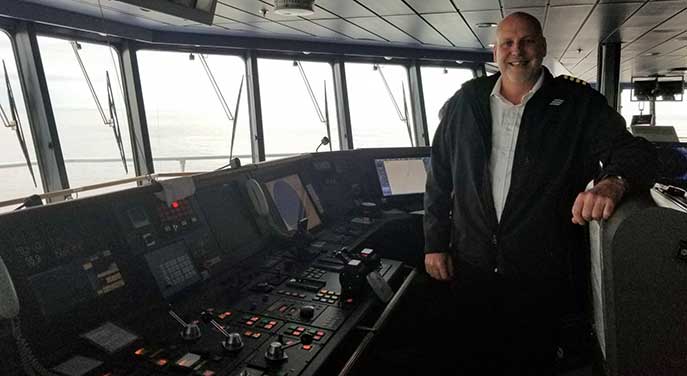 Capt. Stan Peet is the only of five siblings not born on Newfoundland. His father was serving in the military when his youngest son was born in Nova Scotia’s Annapolis Valley. Yet, he considers himself a true Newfoundlander.
Capt. Stan Peet is the only of five siblings not born on Newfoundland. His father was serving in the military when his youngest son was born in Nova Scotia’s Annapolis Valley. Yet, he considers himself a true Newfoundlander.
Canada’s most eastern province, he says, is every bit as much a distinct society as Quebec. Isolated by its geography, it has a culture and heritage as distinct as Quebec’s.
“We are a very proud group of people,” he says. “We are definitely part of Canada, but we are a distinct society.
Peet is serving his province in a vital way – at the helm of the MV Atlantic Vision. The 203-metre-long vessel is the largest passenger ferry in North America, and it makes the daily six-hour trip between North Sydney, N.S., and Port-Aux-Basques, NL. I sat down with him during the trip over to The Rock.
The Atlantic Vision was the jewel in the four-vessel Marine Atlantic fleet when the Crown corporation acquired it in 2008. Built in 2002 in Kiel, Germany, it was one of just a handful of vessels that met the criteria Marine Atlantic had set. Since then, two other vessels in the fleet can handle more than the AV’s 350-car volume, but not more passengers.
Peet was among the team that selected the ship, and he was put in charge when it sailed out of port in Finland when the company took possession. What he hadn’t figured on was that he would be the one to steer North America’s largest passenger vessel out of the European country’s narrow and unfamiliar fjords.
“It was interesting, to say the least,” he says, his eyebrows rising at the memory of the trial by fire.
Although he had decades of experience commanding large ships, including supertankers for Irving Oil, he said every vessel behaves a little differently. “It’s just knowing the feel of the ship,” he says.
Compounding the challenge is adjusting direction to compensate for wind currents that can blow a ship into rocks with little warning. The Atlantic Vision has 4,300 square metres of surface area on the side.
“It’s like having a massive piece of plywood in the wind.”
Although he got out of the port in Finland, the challenge of getting the vessel safely across the Atlantic wasn’t over. The ship encountered a “big storm” in the English Channel with nine-metre waves that tore the ramp off the top deck.
“It was a pain in the ass,” says Peet. “I’d been up for, at this point, 24 hours. When I did finally get back to the cabin, a cupboard door was laying on my bunk.”
These days, the sailing is much smoother. The company does not sail on days when waves exceed five metres or winds exceed 30 knots (56 km/h). This is especially important when sailing into Port-Aux-Basques, where the channel is so narrow there is little room for error.
“You’re seconds away from – if you make the wrong manoeuvre – you’re getting out (on the rocks).” He said he had one occasion a few years ago in which the wind was sending the ship toward the shoals. He avoided a mishap by reversing the engines, backing out and taking another careful approach to the port.
The Atlantic Vision remains an impressive vessel. Powered by four 16-cylinder engines, it sends 62,000 horsepower to its twin propellers. Its hull is also rugged enough that it can sail through Atlantic ice. On at least one occasion, it helped free an ocean liner that had become ice-bound, Peet says.
Peet maintains a close relationship with his crew of 69 (in mid-summer, it swells to 100) and believes in treating everyone on staff as an equal. “I’m no more important than the purser,” he says, “Or the person who will clean the decks. We don’t put ourselves above each other.”
At age 59, he could retire, but he enjoys what he’s doing and wants to stay for at least another five years. He oversees two sailings for two weeks at a time – one around noon and the return trip at midnight. Yet, despite the demanding hours, he is happy with the work/life balance because he gets two weeks off for every two he works.
When he’s home with his wife Janis, he loves to spend days on his personal sailboat.
Peet says separatists, like some in Quebec, who want to go it alone would do well to travel the world and see the state of other countries. It would help them appreciate what they have here, he says.
“Canada is a good country. We are very fortunate.”
ConnecTour is now in Newfoundland and has started the 890 ride from Port-Aux-Basques to St. John’s. It is the final phase of the tour that began on May 28. Watch for more updates from the road.
Doug Firby is an award-winning editorial writer with over four decades of experience working for newspapers, magazines and online publications in Ontario and western Canada. Previously, he served as Editorial Page Editor at the Calgary Herald.
For interview requests, click here.
The opinions expressed by our columnists and contributors are theirs alone and do not inherently or expressly reflect the views of our publication.
© Troy Media
Troy Media is an editorial content provider to media outlets and its own hosted community news outlets across Canada.


